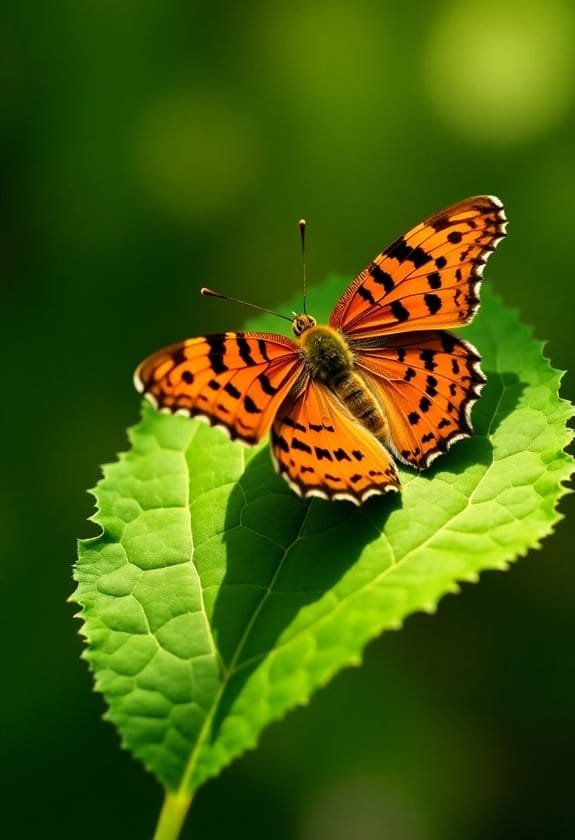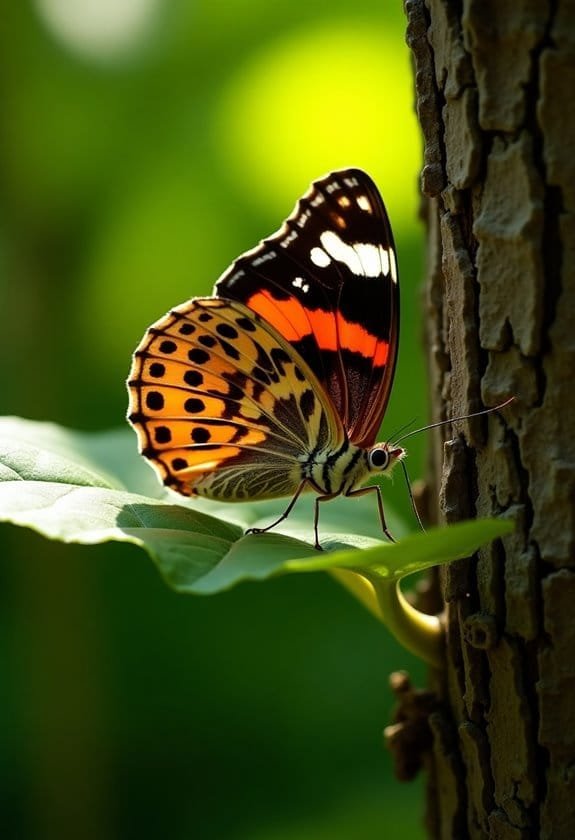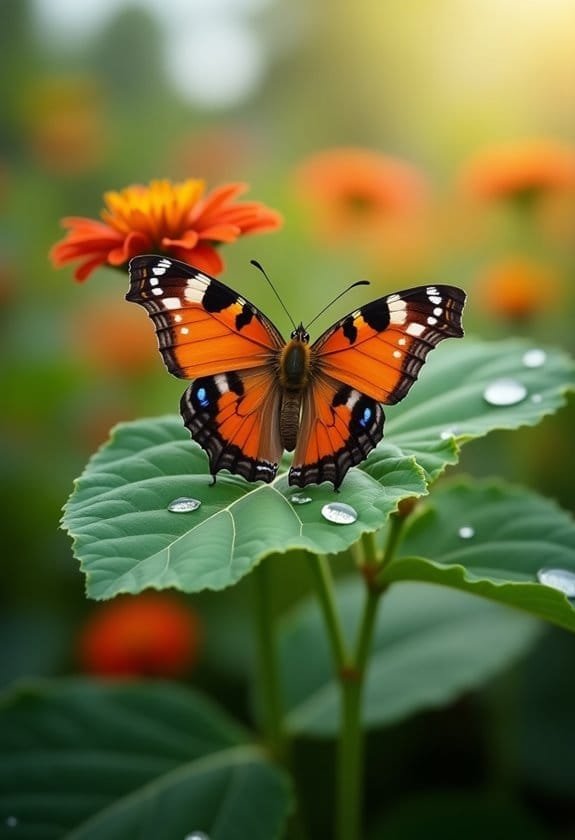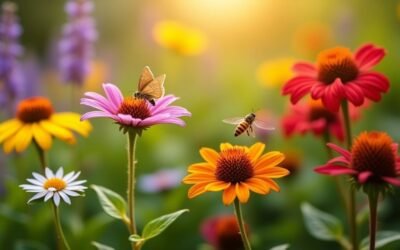The Comma butterfly, scientifically referred to as Polygonia c-album, is a striking species recognized for its orange-brown wings, marked by a distinctive comma-shaped design on the hindwings and a wingspan of 4.5 to 6 cm. This lepidopteran exhibits sexual dimorphism, with males typically smaller and possessing lighter tones compared to their larger, richly colored female counterparts. Beyond their aesthetic appeal, Comma butterflies considerably contribute to ecosystems as pollinators, supporting biodiversity through the fertilization of various wildflowers, while camouflage adaptations enhance their survival against predators. In this way, they play pivotal roles in both agricultural productivity and ecological balance, prompting further exploration into their impressive life cycle.
Main Points
- The Comma butterfly (Polygonia c-album) is identified by its distinctive comma-shaped mark on the hindwings and striking orange-brown coloration.
- Males are smaller than females, and their wingspan ranges from 4.5 to 6 cm.
- This butterfly plays a crucial role in pollinating wildflowers, enhancing biodiversity and ecosystem health.
- Female Commas choose host plants like nettles and currants for optimal larval nutrition, demonstrating adaptive feeding behavior.
- The species is currently stable, but faces threats from habitat loss and climate change, prompting conservation efforts.
Profile

The comma butterfly, scientifically known as Polygonia c-album, exhibits several intriguing physical features, such as its distinctive orange-brown wings adorned with irregular brown markings.
With a wingspan ranging from 4.5 to 6 cm, this species showcases sexual dimorphism, where males are slightly smaller than their female counterparts, adding a layer of complexity to its profile.
Remarkably, the comma butterfly shares its environment with similar pollinators, enriching the biodiversity of habitats like open woodlands and gardens.
Common/Scientific Names
Comma butterflies, scientifically known as Polygonia c-album, belong to the Nymphalidae family. Their common name, the European Comma, aptly reflects their widespread distribution across Europe and parts of Asia. This butterfly gets its unique name from the distinctive comma-shaped mark on the underside of its hindwings, a feature that not only aids in identification but also enhances its camouflage against predators.
Historically, comma butterflies were classified as rare in certain locales, yet recent years have seen them thrive, thanks to favorable climatic conditions that have allowed for an expansion of their habitats. Notably, their life cycle is intricately linked to environmental factors, including climate change, which influences their emergence and reproduction rates.
Currently, in the UK, they're listed as Least Concern on the GB Red List (2022), suggesting a stable population, though ongoing challenges, such as fluctuating temperatures and habitat alterations, could impact future survival.
The resilience of comma butterflies highlights the fascinating interplay between species adaptation and ecological shifts, underscoring the importance of monitoring climate effects on delicate ecosystems.
Key Physical Features
With a wingspan measuring between 4.5 and 5.5 cm, Polygonia c-album showcases a striking presence in the butterfly world. The wings exhibit a vibrant orange hue, intricately adorned with irregular dark brown markings and elegantly scalloped edges, creating a palette that draws the eye. Along its back, the contrasting colors provide an impressive sight, elevating its aesthetic appeal.
The underside of the wings, however, tells a different story. Displaying a marbled brown surface punctuated with white spots, it offers superb camouflage, allowing the Comma butterfly to blend seamlessly with tree bark or fallen leaves when at rest. This adaptation is crucial for evading predators.
One of the butterfly's most distinctive features is the comma-shaped mark on its hindwings, which not only inspired its common name but also enhances its overall allure.
Additionally, sexual dimorphism makes it possible to distinguish between males and females; males typically possess a more fawn orange upperside, while females exhibit a deeper red tone. Such variations contribute to understanding the butterfly's breeding behaviors and ecological roles in their habitats, making them a compelling subject of study in entomology.
Similar Pollinators
Many butterflies, like the Red Admiral and the Small Tortoiseshell, share similar roles as crucial pollinators in their ecosystems. These colorful insects are drawn to a variety of flowers, each exhibiting distinct nectar preferences that influence their feeding habits and, in turn, the plants they pollinate.
The Red Admiral, for instance, is known for its striking black wings adorned with red bands; it migrates extensively, seeking out diverse gardens rich in nectar sources.
The Painted Lady, with its enchanting orange and brown patterns, showcases remarkable butterfly migration patterns as it journeys long distances, effortlessly feeding on an equally wide array of flowering plants. The presence of Common Yarrow(Achillea Millefolium) in gardens can further attract these butterflies, providing essential nectar sources that boost their populations.
Meanwhile, the Peacock Butterfly, notorious for its stunning eye-spots, employs effective garden attraction strategies by favoring nectar-rich flowers such as buddleia, luring the attention of garden enthusiasts.
Additionally, the Common Blue thrives in various meadows, demonstrating how these butterflies not only enrich biodiversity but also contribute considerably to the delicate balance of their ecosystems. The presence of plants like the Common Restharrow(Ononis Repens) enhances habitats for these butterflies by providing essential nectar sources.
Each butterfly serves as a crucial link in a complex web of life, ensuring that flowering plants can reproduce and flourish.
Pollination Role
The comma butterfly plays an essential role in the pollination of various wildflowers, particularly thistles and knapweed, where they seek nectar necessary for their survival.
Their efficient foraging, especially during the blooming seasons of spring and autumn, not only enhances pollination but also fosters genetic diversity among plant populations, important for ecosystem resilience. Greater knapweed serves as a significant nectar source during its long flowering period, attracting many pollinators, including the comma butterfly.
As they transfer pollen between flowers, these butterflies support the production of fruits and seeds that sustain other wildlife, further underscoring their ecological importance. Additionally, by frequenting plants like common knapweed, they contribute to the nourishment of over 70 different insect species, promoting a healthy and diverse pollinator community.
Target Plants/Crops
Comma butterflies play an essential role in pollinating a variety of target plants and crops. These butterflies primarily seek out high-quality nectar sources, favoring wildflowers like thistle and knapweed. Their nectar preferences not only provide fundamental energy but also enhance their effectiveness as pollinators. By visiting these flowers, comma butterflies facilitate the transfer of pollen, a process critical for the fertilization of countless plant species, thereby supporting plant reproduction and seed production.
In addition to wildflowers, adult comma butterflies are often seen feeding on ripe blackberries and fallen fruits, which helps boost the pollination of these fruiting plants. This feeding behavior underscores the necessity of specific habitat requirements, as comma butterflies flourish in diverse garden environments that attract various flowering plants. Furthermore, the presence of Birds Foot Trefoil provides additional nourishment for these butterflies, enhancing their foraging success. Additionally, the presence of nectar-rich flowers like Campanula glomerata offers vital food resources that bolster local pollinator populations.
The presence of these butterflies contributes considerably to the diversity of pollinators, leading to improved pollination rates. The role of comma butterflies in pollination transcends mere nectar acquisition; their activities foster the integrity of both wild and cultivated ecosystems.
Method & Efficiency
During the active months of spring and summer, comma butterflies (Polygonia c-album) exhibit remarkable efficiency in their pollination role. They engage in diverse nectar foraging strategies, actively visiting nectar-rich wildflowers like thistles and knapweed. This behavior is vital, as it not only facilitates their own nutrient intake, but also enhances the reproductive success of various plant species, triggering an impressive increase in genetic diversity.
Their adept foraging methods allow them to gather essential nutrients necessary for reproductive vigor, thereby ensuring the proliferation of their population. As they flit from flower to flower, these butterflies contribute greatly to pollination efficiency, influencing both wild plant ecosystems and agricultural productivity. Furthermore, the presence of species like Rough Hawkbit (Leontodon hispidus) in their habitat provides essential nectar sources that bolster their feeding opportunities.
Moreover, their autumn feeding behaviors shift focus to ripe fruits, such as blackberries and plums. This change not only helps them sustain themselves as winter approaches but also aids in seed dispersal, fortifying the health of the overall ecosystem. Interestingly, their habitat preferences are closely linked to pollinator-rich wildflower areas, which provide critical support for both their feeding and reproduction.
Consequently, comma butterflies play an integral role in maintaining ecological resilience, demonstrating how interconnected their survival is with the broader environment. As a result, their pollination activities extend well beyond mere nourishment, impacting biodiversity and agricultural health alike.
Seasonal Activity
Active throughout spring and autumn, comma butterflies (Polygonia c-album) are key contributors to the pollination process. Their spring emergence marks an important period when they visit a variety of wildflowers, including thistle and knapweed. As they feed on nectar, these butterflies facilitate the reproduction of flowering plants, enhancing biodiversity and supporting ecosystem health. In addition, their attraction to clover species aids in the nitrogen-fixing abilities that benefit soil fertility.
During autumn feeding, adult comma butterflies are often observed indulging in ripe blackberries and fallen fruits. This behavior is essential, as it allows them to build energy reserves required for hibernation strategies. Understanding their polyphagous feeding habits demonstrates their adaptability; they efficiently exploit different floral resources, maximizing their effectiveness as pollinators throughout varying seasons.
Furthermore, the presence of comma butterflies in gardens and open woodlands signals a robust ecosystem. These butterflies thrive in diverse habitats rich in food sources, underscoring their interdependent relationship with the environment. The support of plants like Meadow Vetchling(Meadow Vetchling) is crucial, as they provide essential nectar resources for these butterflies.
Their role in transferring pollen between plants can't be overstated, as it's this dynamic interaction that fosters healthy plant populations, further highlighting their importance in maintaining ecological balance. Indeed, without such active pollinators, the intricate tapestry of our natural world would be irrevocably altered.
Economic Impact
The role of comma butterflies in pollination extends into economic domains, particularly within agricultural settings. Their presence greatly bolsters crop yields by improving cross-pollination, which is essential for the production of fruits and vegetables. This increased efficiency not only supports local economies but also provides substantial economic benefits that ripple through various sectors.
Moreover, these butterflies are critical for agricultural sustainability. By promoting biodiversity, they help maintain healthy ecosystems, allowing farmers to rely less on chemical fertilizers and pesticides. As they actively visit nectar-rich flowers like thistle and knapweed, the resultant pollination services contribute to enhancing the productivity of pollinator markets. Additionally, goldenrod, due to its late-season blooming, supports butterflies like the comma by providing nectar-rich resources, which are crucial for their survival.
The health of an agricultural landscape often mirrors the wellbeing of its pollinators, including comma butterflies. As indicators of habitat quality, their populations can reveal underlying environmental changes that may affect agricultural viability. This insight is indispensable for conservation efforts that aim to protect both the butterflies and the agricultural practices dependent on their pollination prowess. Additionally, their attraction to nectar-rich flowers like chicory supports not only their own life cycle but also contributes to the overall pollination efficacy within the agricultural ecosystem.
Adaptations

The Comma butterfly's adaptations are a fascinating interplay of physical features and behavioral traits that enhance its survival.
With its wings shaped like dead leaves, it skillfully merges into its woodland habitat, while the larvae's resemblance to bird droppings offers a clever camouflage against predators.
Seasonal changes in coloration, along with the development of spines in later larval stages, further exemplify the intricate specializations that equip this butterfly for the challenges of its environment.
Physical Features
With its striking physical features, the Comma butterfly showcases several adaptations that enhance its survival. Its remarkable wing morphology, characterized by strong, irregularly dentate margins, gives the butterfly a distinctive angular shape, aiding in blending into varied environments. The vibrant orange coloration, beautifully contrasted with brown markings on the upper surfaces, serves as a visually arresting display.
When the wings are closed, however, the marbled brown underside mimics the appearance of a dead leaf, a clever camouflage strategy that provides excellent concealment.
Further illustrating this adaptability, Comma butterfly caterpillars are adorned with branched spines, cleverly mimicking bird droppings—this adaptation greatly improves their protection from hungry predators. Additionally, adult butterflies exhibit sexual dimorphism; males' wingspans range from 22 to 24 mm, while females stretch slightly larger at 25 to 26 mm, facilitating species recognition during mating.
During hibernation, these butterflies become adept at camouflage, often resting in hollow trees or log piles, where their closed wings create a jagged outline, blending seamlessly into the surrounding foliage. Through these unique physical features, the Comma butterfly guarantees its continued existence in a challenging environment.
Behavioral Traits
Behavioural traits of the Comma butterfly play a crucial role in its survival and reproductive success. One notable adaptation is its mimicry strategies; resting with its wings closed, it resembles dead leaves, effectively camouflaging itself from predators. This clever technique not only protects the adult butterflies but also benefits their larvae, which mimic bird droppings, additionally enhancing their chances of evasion.
Males demonstrate distinct territorial behaviors, defending specific areas to attract females. This display of dominance correlates positively with their lifespan, as successful territories often lead to increased mating opportunities.
Moreover, the Comma butterfly adopts a polyandrous mating system, where females mate with multiple males, thereby maximizing their reproductive success. This strategy contributes to greater genetic diversity among their offspring, essential for adapting to environmental changes.
During colder months, the Comma butterfly seeks sheltered locations, such as hollow trees or log piles, allowing them to survive winter hibernation.
These behavioral adaptations highlight the intricate ways in which the Comma butterfly navigates its environment, weaving a delicate balance between survival and reproduction. As a result, these traits guarantee both the endurance of the species and the health of future generations.
Specializations
Camouflage plays an indispensable role in the survival strategies of the Comma butterfly. These insects feature remarkably irregular wing shapes and distinct color patterns, allowing them to blend seamlessly with tree bark and fallen leaves during moments of rest. This effective use of camouflage strategies is vital for evading predators in their natural habitat.
In their earlier stages, Comma caterpillars exhibit larval mimicry by resembling bird droppings, greatly decreasing their chances of predation. As they mature through later instars, these caterpillars develop branched spines, providing a limited but notable defense against potential threats.
Moreover, the Comma butterfly showcases seasonal dimorphism, with individuals adopting darker hues during diapausing phases. This adaptation allows them to remain hidden from predators during the colder months, therefore enhancing their winter survival rates.
In addition to these physical adaptations, males engage in territorial behavior, fiercely defending specific areas to maximize mating opportunities. This behavior reinforces sexual selection, promoting genetic diversity and stability within the population.
Plant Relationships
How do Comma butterflies promise the successful development of their young? Through meticulous host plant selection, female Comma butterflies ascertain their larvae have prime access to high-quality nutritional sources. They prefer plants like stinging nettles (Urtica dioica) for caterpillar feeding, acknowledging that these plants bolster larval nutrition and enhance developmental efficiency. By laying eggs on nutrient-rich host plants, they maximize the chances of survival for their offspring.
Additionally, the caterpillars exhibit remarkable adaptability, adjusting their feeding behavior in response to the seasons. During early instars, remarkable growth requires them to seek out the healthiest plant materials available, thereby reinforcing their survival strategy within their environment. Their host plant selection is influenced by the ecological benefits mediated by plant interactions which provide crucial resources for their growth.
Besides nettles, they exploit other plant species such as hops, elm, currants, and willows, each selected for their nutritional value. This selective process demonstrates an intricate relationship between the Comma butterfly's life cycle and ecological conditions, as fluctuations in weather can influence host plant availability. In gardens, incorporating plants like Creeping Cinquefoil can enhance the availability of flowering resources that attract pollinators and provide vital support for butterfly populations.
Ultimately, their strategic adaptations reflect an evolutionary refinement in recognizing and utilizing plant relationships essential for thriving, guaranteeing that each new generation flourishes in the delicate balance of their habitat.
Ecosystem Impact
The comma butterfly plays an essential role in its ecosystem, acting as both a pollinator and a food source within the intricate food web.
By aiding in the reproduction of various flowering plants and serving as nourishment for birds and other predators, it greatly contributes to local biodiversity and stability.
In addition, its specific habitat dependencies, particularly on stinging nettles, highlight its influence on plant community dynamics and overall environmental health, showcasing the delicate balance of nature.
Biodiversity Contribution
Contributing considerably to biodiversity, the comma butterfly (Polygonia c-album) plays an essential role in its ecosystem as a pollinator and a food source. This butterfly facilitates the reproduction of various flowering plants, particularly notable wildflowers like thistle and knapweed, enhancing their populations.
Through its interactions within pollinator gardens, the comma butterfly impacts plant community dynamics, increasing species richness and promoting a healthy ecosystem.
The larvae, which thrive on host plants such as stinging nettles and currants, greatly influence local herbivore populations, creating a complex web of interdependencies. Their presence often reflects the health of the ecosystem, as the butterflies respond sensitively to habitat changes, thereby serving as valuable indicators for ecosystem monitoring.
As a food source for birds and various insects, these butterflies help maintain ecological balance by sustaining predator populations.
Additionally, their contribution to habitat restoration efforts is crucial, as increasing comma butterfly numbers can lead to enhanced biodiversity. Consequently, the comma butterfly embodies a critical link in ecological health, underscoring the importance of conservation efforts that support these remarkable pollinators and their habitats.
Food Web Position
While comma butterflies serve as crucial pollinators, their role in the food web extends well beyond this function. These enchanting insects occupy critical ecosystem roles, supporting biodiversity by engaging in predator interactions and promoting intricate relationships within their environment.
The larvae primarily feed on plants like stinging nettles, effectively managing these populations and fostering ecological balance. This feeding behavior not only controls plant growth but also aids in nutrient cycling, enriching the soil and benefiting surrounding flora.
Furthermore, comma butterflies represent an important food source for various predators, such as birds and predatory insects. Their presence within ecosystems signals a healthy and balanced environment, as they depend on diverse host plants for survival and development.
The delicate balance achieved through these interactions embodies the interconnectedness of life forms, where each organism contributes to the stability of its habitat.
In essence, the comma butterfly's multifaceted role—as both herbivore and pollinator—enhances ecosystem resilience, demonstrating the profound complexity of food webs. By facilitating nutrient cycling and serving as prey, they reinforce the web of life, making them indispensable components of their ecological communities.
Habitat Dependencies
Habitat diversity is crucial for the survival of comma butterflies, as these insects thrive in open woodlands, edges, and gardens rich in their larval food plants like stinging nettles, hops, and willows. This dependence on specific habitats underscores their vulnerability to habitat fragmentation, which disrupts the interconnectedness necessary for a stable ecosystem.
The diversity of these environments guarantees the availability of nectar-rich flowers for adult butterflies, while also offering suitable laying sites for females, ultimately supporting their life cycle.
Moreover, climate change has enhanced the comma butterfly's climate adaptability, allowing it to expand its range northward and utilize a wider variety of host plants. This resilience reflects a remarkable ecological flexibility crucial for maintaining their populations amid changing conditions.
However, habitat loss threatens their stability, highlighting the importance of conservation efforts aimed at preserving these critical woodland habitats. As comma butterflies adapt to diverse environments, they contribute to ecological resilience, impacting the myriad interconnected species within their ecosystems. Alongside their ecological contributions, these butterflies also serve as vital indicators of environmental health and ecosystem stability.
Therefore, safeguarding their habitats is imperative, as each vibrant butterfly not only enriches the landscape but also fortifies the intricate web of life around it.
Environmental Services
The comma butterfly plays an essential role in maintaining ecological balance by serving as a key pollinator for various flowering plants. This species greatly contributes to plant reproduction, enhancing biodiversity within ecosystems, which is critical for resilience against environmental changes. By pollinating diverse flora, comma butterflies help guarantee the continuation of many plant species, thereby acting as important ecosystem indicators.
Furthermore, their larvae feed primarily on stinging nettles and other plants, facilitating vigorous nutrient cycling. As they consume and decompose plant material, they return fundamental nutrients to the soil, supporting the health of their habitat. Germander Speedwell (Veronica chamaedrys) often thrives in similar areas and provides crucial nectar sources for local pollinators like the comma butterfly.
Additionally, comma butterflies serve as prey for numerous birds and other predators, creating crucial links in food web dynamics that sustain various populations.
Their ability to adapt to changing climates highlights their role in climate resilience and reflects their status as indicator species. By thriving in diverse habitats rich in flora, the presence of comma butterflies signals a healthy ecosystem, showcasing environmental quality. In gardens, their interactions with plants like wild marjoram demonstrate the importance of ecological partnerships in pollination and plant health.
Consequently, safeguarding the comma butterfly not only benefits its immediate environment but also underscores the interconnected nature of all living organisms in maintaining ecological health.
What are the differences between the Comma Butterfly and Sulphur Butterfly?
The main differences between the Comma Butterfly and sulphur butterfly species lie in their physical appearance and habitat preferences. While the Comma Butterfly features a distinct white comma-shaped marking on its wings, the Sulphur Butterfly species typically displays bright yellow or orange coloration. Additionally, Sulphur Butterflies tend to favor open, sunny habitats, while Comma Butterflies are commonly found in wooded areas.
Conservation

The Comma butterfly's population currently enjoys a status of Least Concern, yet ongoing conservation efforts remain critical for its long-term survival.
Despite its stable numbers, habitat restoration and protection measures are essential to guarantee these butterflies flourish in their preferred environments, such as open woodlands and vibrant gardens.
With climate change influencing their range and dietary preferences, proactive measures, including community involvement and monitoring initiatives, are imperative for maintaining healthy populations amid evolving threats.
Population Status
With a stable population across Europe, the comma butterfly (Polygonia c-album) is currently listed as Least Concern on the GB Red List. This classification reflects its recovery from historically low numbers during the 19th century, thanks to dedicated conservation efforts, particularly habitat restoration.
Monitoring programs reveal promising population trends, most significantly in southern England, where numbers have increased remarkably. Additionally, the northward expansion of its range suggests adaptability, likely influenced by climate change, which creates more favorable conditions for this species.
Public engagement in butterfly conservation has soared, resulting in enhanced identification and monitoring initiatives that promote awareness and appreciation for these delicate creatures. Such efforts have led to more thorough data collection, essential for understanding and supporting the comma butterfly's continued survival.
While current trends appear encouraging, it's crucial to remember that habitat loss and climate influences persist as challenges that could jeopardize these advancements. Consequently, ongoing conservation work remains indispensable.
With proactive measures, we can foster resilient populations of comma butterflies, ensuring that these stunning insects continue to grace our landscapes for generations to come.
Current Threats
Urban sprawl and agricultural expansion threaten the comma butterfly's habitat, despite its current status as Least Concern. This degree of concern, however, shouldn't mask the pressing dangers these butterflies face.
The relentless encroachment of urban development and farming diminishes the flora key for their survival, particularly stinging nettles, which are essential for caterpillar nourishment. With fewer host plants available, larval development and survival rates decline.
Climate change compounds these threats, altering environmental conditions that affect the butterfly's distribution, breeding patterns, and habitat preferences. As temperature shifts occur, successful climate adaptation becomes increasingly challenging for the species.
Furthermore, pesticide use in farming and gardening diminishes food sources for both larvae and adults, adding to their vulnerability. The pollinators they depend on can be severely impacted by such chemicals, further destabilizing the ecosystem.
Habitat preservation initiatives are important to counteract these risks. Promoting pesticide alternatives can safeguard against the loss of both food and habitat, enabling the comma butterfly's population recovery efforts to continue. Great Burnet can serve as a beneficial plant in conservation efforts, providing nectar resources and habitat support for pollinators.
Effective programs to monitor and respond to these threats remain essential for ensuring the long-term survival of this remarkable species.
Protection Measures
Conservation efforts frequently focus on enhancing habitats that sustain the comma butterfly. In particular, initiatives emphasize habitat improvement, targeting open woodlands and gardens where diverse ecosystems flourish.
The maintenance of these habitats is vital, as they create a conducive environment for not just the comma butterfly, but also other pollinators like the Greater Birds-Foot Trefoil(Lotus pedunculatus), which supports local biodiversity.
Community involvement plays a significant role in these conservation initiatives. Organizations such as Butterfly Conservation provide resources that educate and empower citizens, inviting them to participate in efforts to support local butterfly populations.
By engaging the public, conservationists can bolster awareness and action around habitat needs.
Moreover, monitoring strategies are integral to understanding population dynamics and distribution trends of the comma butterfly. Ongoing programs, utilizing citizen science, track fluctuations in sightings and habitat utilization.
These strategies enable researchers to assess the effects of climate change and habitat diversity, which have positively impacted the species over recent decades. Additionally, creating habitat competition through the introduction of native plant species can help mitigate the aggressive spread of invasive plants like creeping buttercup.
Ultimately, these concerted efforts in habitat improvement, community involvement, and vigilant monitoring serve to guarantee that the comma butterfly continues to thrive in its natural environment, symbolizing a commitment to broader biodiversity.
Support Guidelines
Effective support for comma butterfly conservation hinges on practical guidelines that empower individuals and communities. Habitat restoration efforts play an essential role in maintaining robust ecosystems, as these butterflies thrive in diverse environments, including woodlands and shrublands. By enhancing these habitats, the Comma butterfly can continue to flourish, further contributing to overall biodiversity.
Community engagement initiatives, spearheaded by Butterfly Conservation, actively involve local residents in monitoring and restoration projects. Participants learn to identify the Comma butterfly and its habitats, fostering awareness and deepening their connection to nature. Such programs not only cultivate a sense of stewardship but also harness collective efforts towards more effective conservation strategies.
Moreover, climate adaptation is essential in addressing the challenges posed by global warming, which may shift the butterfly's range. By implementing adaptive management practices, conservationists can respond flexibly to changing environmental conditions, ensuring the long-term survival of the Comma butterfly in the face of uncertainty.
Historical population recoveries remind us that, with dedicated action and ongoing support, it's possible to secure a thriving future for this species, enriching the tapestry of life in British landscapes.
Research Notes
Research on the comma butterfly has revealed fascinating insights into its behavior, habitat preferences, and population dynamics.
Key studies emphasize the importance of host plant quality for reproduction, while highlighting knowledge gaps regarding the insect's responses to ongoing climate shifts.
As the field advances, referencing foundational studies will be essential for informing future conservation strategies and enhancing overall understanding of this remarkable species.
Key Studies
Examining the behavior and ecological adaptations of the Comma butterfly reveals captivating insights into its reproductive strategies and survival mechanisms. Research highlights that the Comma employs a polyandrous mating system, allowing females to mate with multiple males. This tactic enhances fertilization success, ultimately optimizing reproductive outcomes.
In terms of larval development, female butterflies judiciously select host plants that promote rapid growth for their caterpillars, thereby streamlining their life cycle. Efficient development is vital for increasing offspring survival rates in fluctuating environments.
Additionally, the larvae exhibit remarkable camouflage strategies, mimicking bird droppings—a truly ingenious adaptation that protects them from various predators, both vertebrate and invertebrate.
Moreover, studies have tracked significant shifts in the Comma butterfly's population dynamics, showcasing recovery in southern England due to effective habitat restoration efforts and evolving agricultural practices that favor their survival.
Notably, climate change dynamics are also reshaping their geographic distribution, with rising temperatures enabling expansion into previously uninhabited northern territories.
These complex interrelations between mating systems, ecological adaptations, and environmental changes underscore the resilience of the Comma butterfly within its landscape.
Knowledge Gaps
While the Comma butterfly's adaptability and resilience have been highlighted in existing studies, several knowledge gaps still hinder a thorough understanding of this species. For instance, the specific climate impact on the reproductive success and larval development of the Comma butterfly remains inadequately explored. Understanding how changing temperatures and precipitation patterns affect these essential life stages will enhance conservation strategies.
Moreover, the nutritional importance of host plants used by Comma butterflies varies geographically, yet extensive research on this variation is lacking. It's important to investigate which plants offer ideal nutrition to maximize larval growth and survival.
Additionally, the ecological role of the Comma as a pollinator requires further attention, particularly in evaluating its contributions to biodiversity and food web dynamics across different habitats.
As urbanization continues to increase, the urban effects—such as habitat fragmentation—pose significant threats to the distribution and population dynamics of this species.
Future studies addressing these knowledge gaps will provide critical insights into the Comma butterfly's ecology, facilitating more effective conservation efforts and sustainable habitat restoration initiatives for its long-term survival.
References
The study of the Comma butterfly reveals a trove of fascinating insights, yet the existing literature isn’t exhaustive. Significant gaps remain, particularly regarding its ecological significance and adaptive traits. For example, more research is needed to understand the specific role of the Comma butterfly in its habitat and how it interacts with other species. Additionally, there is a lack of comprehensive information on the adaptive traits that have allowed the Comma butterfly to thrive in its environment. Future studies should also examine the potential impact of environmental changes on the apollo butterfly habitat and the implications for the population of the Comma butterfly.
The Comma butterfly (Polygonia c-album) exhibits a unique polyandrous mating behavior; females select mates based on environmental factors, a choice impacting the larval development process. Understanding this behavior might illuminate broader ecological interactions within its habitats.
Furthermore, the influence of climate change on the Comma butterfly's geographic range can't be overlooked. As temperatures rise, these butterflies have expanded their habitats, particularly noted in the UK, where once-restricted populations now thrive.
This shifting distribution brings to light questions about the species' resilience and adaptability in the face of climate pressures.
Researchers have documented the butterfly's reliance on stinging nettles during its larval stage and on diverse wildflowers during adulthood. This feeding behavior underlines the interconnectedness of flora and fauna, emphasizing the Comma's role in maintaining biodiversity.
Collectively, further research into these facets could reveal not only the adaptive strategies of the Comma butterfly but also the broader ecological implications of its changing landscape.


